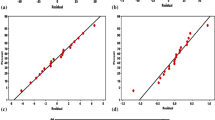Abstract
The present study illustrates the manufacturing aspects of composite with different wt% of SiC particulates as reinforcement in the aluminum alloy matrix developed through investment casting route. The composites were prepared by varying certain process parameters like preheating temperature of particulates, percentage reinforcement and stirring speed. Detailed micro-structural characterization and estimation of mechanical properties (viz., strength, hardness and porosity measurement) are necessary supplements to this investigation. A mathematical model is developed using regression analysis technique for prediction of optimum process parameters viz. percentage reinforcement, preheating temperature of particulates and stirring speed for producing MMCs with enhanced mechanical properties and adequacy of the model has been validated using analysis of variance techniques. Finally the optimization of parameters has also been done using design expert software. The authors have achieved 81.56 % desirability level using multi-response optimization; the optimum value of process parameters would lead to enhanced mechanical properties of cast component.



Similar content being viewed by others
References
Kumar S, and Balasubramanian V, Tribol Int 43 (2010) 414.
Min S T, Trans Nonferrous Metal Soc 19 (2009) 1400.
Mantaux O, Lacoste E, and Danis M, Compos Sci Technol 62 (2002) 1801.
Lee P D, Chirazi A, and See D, J Light Met 1 (2001) 15.
Mandal N, Roy H, Mondal B, Murmu N C, and Mokhopadhyay S K, J Mater Eng Perform 21 (2012) 17.
Taha A M, Mater Manuf Process 16 (2007) 619.
Cabrera O, Ramirez M, Campillo B, and Gonzalezrivera C, Mater Manuf Process 23 (2008) 46.
Miller W S, and Humphreys F J, J Scr Mater 25 (1991) 33.
Ramu G, and Buari R, J Mater Des 30 (2009) 3554.
Pavan R C, Creus G J, and Maghous S, J Compos Struct 91 (2009) 84.
Li Y M, and Li R D, Sci Technol Adv Mater 2 (2001) 277.
Mondal B, Kundu S, Lohar A K, and Pai B C, Mater Sci Eng A 498 (2008) 37.
Wang S, Miranda A G, and Shih C, Mater Manuf Process 25 (2010) 1482.
Pal D, and Ravi B, Virtual Phys Prototyp 2 (2007) 197.
Sajjadi S A, Ezatpour H R, and Beygi H, Mater Sci Eng A 528 (2011) 8765.
Kok M, J Mater Process Technol 161 (2005) 381.
Tham L M, Gupta M, and Cheng L, J Mater Process Technol 89-90 (1999) 128.
Shasha Y, Peng Z, Yunhui Du, Jun Z, and Xiaopeng L, China Foundry 02 (2012) 154.
Singh L, Ram B, and Singh A, Int J Res Eng Technol 02 (2013) 375.
Singh D, Singh H, Kumar S, and Singh G, Int J Emerg Technol 204 (2012) 178.
Muhammed O S, Saleh H P, and Alwan H L, Eng Technol J 27 (2009) 1143.
Giri B K, Pettersson F, Saxén H, Chakraborti N, and Giri B K, Mater Manuf Process 28 (2013) 776.
Giri B K, Hakanen J, and Miettinen K, Appl Soft Comput 13 (2013) 2613.
Niranjan K, and Lakshminarayanan P R, Ttans Nonferrous Metal Soc 23 (2013) 1269.
Hang S J, Kim H M, Huh D, Suryanarayana C, and Chun B S, Mater Sci Eng A 347 (2003) 198.
Zhang H, Geng L, Guan L, and Huang L, Mater Sci Eng A, 528 (2010) 513.
Yang G, Fan T, and Zhang D, J Mater Sci 39 (2004) 3689.
Prabu S B, Karunamoorthy L, Kathiresan S, and Mohan B, J Mater Process Technol 171 (2006) 268.
Acknowledgments
The authors would like to acknowledge Dr. Pijush Pal Roy, Director, CSIR-Central Mechanical Engineering Research Institute, Durgapur for his constant source of inspiration in writing this paper. The authors also acknowledge the financial support from Council of Scientific & Industrial Research, New Delhi to carry out the research work. The authors are also gratefully acknowledged all the staff members of CAMP group for their continuous effort in the experimentation part of the paper.
Author information
Authors and Affiliations
Corresponding author
Rights and permissions
About this article
Cite this article
Goyal, H., Mandal, N., Roy, H. et al. Multi Response Optimization for Processing Al–SiCp Composites: An Approach Towards Enhancement of Mechanical Properties. Trans Indian Inst Met 68, 453–463 (2015). https://doi.org/10.1007/s12666-014-0476-6
Received:
Accepted:
Published:
Issue Date:
DOI: https://doi.org/10.1007/s12666-014-0476-6



